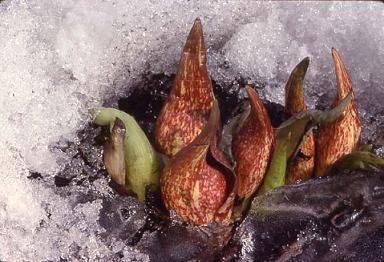© 2006 All Rights Reserved. Do not distribute or repurpose this work without written permission from the copyright holder(s).
Printed from https://danginteresting.com/warm-blooded-plants/

If you live in the Northeastern US, and you walk in the woods on spring mornings, you’re likely to see a skunk cabbage. Indeed, you might see a skunk cabbage growing while the snow is still on the ground. What you may not notice, unless you look closely, is that the snow around the skunk cabbage has melted. It’s not a spectacular sight, but around all of the skunk cabbages you see, there will be a small hole in the snow.
What’s happening here? Is the sun warming the darker plants and melting the snow? No. Actually, the phenomenon you’re seeing is called thermogenesis, and it’s a normal ability of the plant. Or to put it another way, the eastern skunk cabbage is warm-blooded. Its ability to generate heat enables it to grow and flower while the snow is still on the ground – even though the plant is not frost-resistant. The frost will never touch it.
Thermogenesis is rare in plants, but does occur in several species of Arum, and in the philodendron, as well as the skunk cabbage. The heat generation of these thermogenic plants is not trivial, either. Recent measurements of the titan arum “Ted”, at UC Davis, showed the inflorescence— the flower-like structure of the arum— could maintain a temperature of 32 degrees Centigrade (90 F), well above the surrounding air temperature of 20 C (68 F). The skunk cabbage can do even better, maintaining temperatures as high as 35 C, even when the air temperature is below freezing.
Why do these plants do this? What possible benefits could accrue? Surprisingly, it appears that they did not develop their unique ability as a way to ward off the cold. While the skunk cabbage certainly uses its thermogenic abilities to be able to bloom earlier, most thermogenic plants come from warmer, or even tropical climes. The arums being fairly ancient plants, it seems more likely that the skunk cabbage has merely found another use for an already existing ability. So why would tropical plants need to heat up?
The answer, according to most biologists, is simple – the need to attract pollinators. Many arums, such as the titan arum mentioned above, bloom infrequently (as rarely as every 8 to 10 years in some cases), and so their pollinators need to be able to find them quickly, and from far away. By heating up the plant can render its scent more volatile, and therefore more easily disseminated. The titan arum’s distinctively horrible scent, which has earned it the name “the Corpse Flower”, can be detected more than a mile away. Once the pollinators, usually insects, have been attracted, the warm inflorescence also makes an attractive place to rest. The need to spread scent widely is the same drive that gives the titan arum its enormous central spadia (the central pillar, seen in the photo). That spadia, and the surrounding inflorescence make up the largest floral structure in the plant world – up to three meters tall.
The advantage of thermogenesis must be strong, because the energy demands on the plant are huge. It is estimated that the skunk cabbage, when maintaining its heat against sub-freezing temperatures, uses as much metabolic energy as a small rodent, or even a hummingbird. Normal plant metabolism is much slower, so this much energy usage is remarkable. In order to generate all this energy, thermogenic plants use an entire alternate respiratory process, one that uses mitochondria and fats, neither of which is involved in normal plant respiration. The whole process, in other words, looks rather more like animal metabolism than normal plant metabolism. This energy cost is undoubtedly why most thermogenic plants don’t maintain heat constantly, but rather use it sparingly. In the arums, only the inflorescence itself heats up, and then only during the day. The skunk cabbage uses heat more lavishly, presumably to protect itself from the cold, but once the snow is gone and blooming is over, it too reverts to normal cold-blooded plant behavior.
Perhaps we should be grateful that plants only use this particular pathway for heat generation. After all, with all that available energy, who knows what they could do by using it for something more than just a little heat. The great monsters of tomorrow may not come from outer space, or the laboratory, but from our backyards.
© 2006 All Rights Reserved. Do not distribute or repurpose this work without written permission from the copyright holder(s).
Printed from https://danginteresting.com/warm-blooded-plants/
Since you enjoyed our work enough to print it out, and read it clear to the end, would you consider donating a few dollars at https://danginteresting.com/donate ?